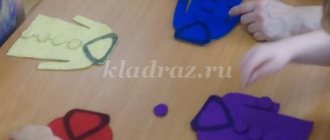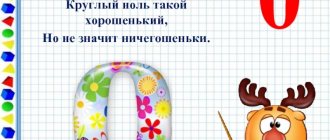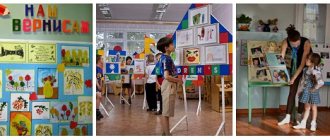Card games for developing fine motor skills
- I’ll draw a berry - the children outline the contours of the berries drawn on a sheet of paper with small beads.
- Needles - the child should roll a hair brush (round) in his palms, imagining that these are needles from a Christmas tree.
- Guess the letter - two teams of guys. Each one sculpts a letter given by the teacher. Then the children take turns and, with their eyes closed, must determine by touch what letter their opponents have made.
- Snow made of napkins - children are given a napkin each. You need to tear it into small pieces with your fingers to make snow, without helping with your other hand. The one who finishes it the fastest wins.
- Feed the piglet - add legs and a muzzle to the plastic bottle that lies on the table. Ask the children to feed the piglet, putting beans and peas in the neck.
LiveInternetLiveInternet
September 1st week: Topic “Kindergarten and toys” 1. Finger gymnastics: “Friendship” “Visiting the big finger” “Ball”. 2. “Stick figures” (swing). 3. Playing with peas or beans (put out a toy, ring, cube). 4. An affectionate game for fingers “Wonderful bag” (select the one you need by touch from three toys). 5. “Complete the pattern” Week 2: Theme “Berries” 1. Finger gymnastics: “Hello” “Grass” “This finger” 2. “Stick figure” (basket for berries). 3. Playing with pebbles (lay out the berries along the contour). 4. Nitkography (clearing). 5. Complete the pattern. Week 3: Theme “Mushrooms” 1. Finger gymnastics: “Basket”, “For mushrooms” 2. Stick figures (put out a mushroom and a stump). 3. Game with pearl barley (mushrooms). 4. Tender game for fingers “Wonderful bag, find the fungus among other objects.” 5. Drawing based on the image of light geoms. figures. 6. Complete the pattern. Week 4: Topic “Vegetables” 1. Finger gymnastics: “Pickling cabbage” 2. Stick figures (the car carries the harvest from the fields). 3. Game with red beans (put out the beets). 4. Playing with a tennis ball, holding it between your fingers. 5. Complete the pattern. October 1 week: Theme “Migratory birds” 1. Finger gymnastics: “Flock of birds” “birdhouse” “Chicks in the nest” 2. Figures from twigs (flocks of birds) 3. Game with women and peas (sort the women and peas with your eyes closed ). 4. “Get to know me!” (connect the dots with one line) “Swan” 5. Complete the pattern Week 2: Theme “Poultry” 1. Finger gymnastics: “Ducklings” “Goose” “Cockerel” “Hen”. 2. Working with gouache [color the chickens with yellow gouache with your fingertips, crumple the paper into small lumps - food] 3. Playing with rice: (circle the duckling along the contour and lay it out with rice) 4. Self-massage with faceted pencils 5. Complete the pattern. Week 3: Topic “Mail” 1. Finger gymnastics: “Guests” “Mailbox 2. Stick figures (envelope). 3. Working with gouache (draw a postcard with your fingertips). 4. Art work (envelope) 5. Complete the pattern. Week 4: 1. Finger gymnastics: “Fingers” 5 “Rakes” 2. Stick figures 3. Plucking (shape of leaves of various trees) 4. Self-massage with balls. 5. Nitkography (autumn trees). 6. Complete the pattern. November 1 week: Theme “Family” 1. Finger gymnastics: “My family” “Who arrived” 2. Stick figures (face, glasses). 3. Working with semolina (use your fingertips to draw a cheerful person on the semolina.) 4. Beads as a gift for mom from lumps of paper. 5. Game "Piano". 6. Complete the pattern. Week 2: Theme “Our City” 1. Finger gymnastics: “The lawn is dry” “Well” 2. Figures from sticks (tower, house) 3. Figures from branches (kindergarten building, group plan) 4. Working with pebbles (road and cars) 5. Self-massage with faceted pencils. 6. Complete the pattern. Week 3: Theme “Our Motherland” 1. Finger gymnastics: “Hello” “Warm up” 2. Stick figures (sun). 3. Work with millet (lay out a drawing along the contour) 4. Game (use a stick with your eyes closed to identify the object) 5. Mosaic panel based on Russian folk painting. 6. Complete the pattern. Week 4: Theme “Winter” 1. Finger gymnastics: “Let’s warm ourselves up” “Ice” “Frost” 2. Game: “Put ice into molds” 3. Working with cotton wool (snowdrifts) 4. Working with thin paper strips (snowflake in smaller image). 5. Complete the pattern. December 1 week: Theme “Wintering Birds” 1. Finger gymnastics: “Pigeons” “Sparrows” 2. Working with small geometric shapes (bird) 3. Breaking (decorate the bullfinch with small pieces) 4. Thread printing (winter forest) 5. Beadwork. 6. Complete the pattern. Week 2: Theme “Winter Fun” 1. Finger gymnastics: “Snowball” “Snowman” 2. Stick figures (sled) 3. Working with rice (winter landscape) 4. Self-massage with balls. 5.Complete the pattern. Week 3: Theme “New Year” 1. Finger gymnastics: “Holiday” “Christmas tree” 2. Stick figures (Christmas tree) 3. Tearing (toys for the Christmas tree) 4. Mosaic of Christmas tree and pine needles. 5. Complete the picture. Week 4: Theme “Dishes and food” 1. Finger gymnastics: “Naughty” “we washed the dishes” 2. Stick figures: (sweets, saucepan, box) 3. Tender fingers “Wonderful bag” 4. Game with rice (from large dishes in several small ones.) 5. Playing with peas (lay out any tea utensils) 6. Complete the pattern. January 1 week: Topic “Clothes and shoes” 1. Finger gymnastics: “mittens, boots, hooks” 2. Working with buttons, hooks, zippers, locks. 3. Working with lacing. 4. Stretching the elastic band (holding the ends with your fingers) 5. Working with waste material (decorate clothes, shoes) 6. Weaving a pattern from multi-colored laces. 7. Complete the pattern. Week 2: Theme “Pets” 1. Finger gymnastics: “Met”, “Horses” “Sheep” “Dog” “Cat” “Goat” 2. Stick figures (pussy) 3. Work with pearl barley (calf along the contour) 4. Working with stamps 5. Complete the pattern. Week 3: Theme “Wild Animals” 1. Finger gymnastics: “Our Meadow”, “Hedgehog” 2. Stick figures (hedgehog) 3. Threadography. 4. Self-massage with a faceted pencil. 5. Complete the pattern. February 1 week: Theme “Animals of hot countries” 1. Finger gymnastics: “Turtle” “Elephant” 2. Working with pebbles (elephant along the contour) 3. Trace the drawing along the line without lifting the pencil from the paper. 4. Working with waste material (favorite animal) 5. Beading (peacock tail) 6. Complete the pattern and color without going beyond the outline Week 2: Theme “Defenders of the Fatherland” 1. Finger gymnastics: “Soldiers” “Well done fighters” 2 Stick figures (tank, plane). 3. Working with rice (fireworks on blue cardboard) 4. Competition “Who can tie the most knots on a rope” 5. Stamping with your finger (complete the image) 6. Complete the pattern and color without going beyond the outline. ,11 Week 3-4: Theme “Fish” 1. Finger gymnastics: “Fish” 2. Stick figures (fish, shell). 3. Working with colored wool threads (aquarium) 4. Working with stamps (transformation into a fish) 5. Working with semolina (storm) 6. Threadography (waves) 7. Complete the pattern and color without going beyond the outline. March 1 week: Theme “Spring” 1. Finger gymnastics: “Spring rain” 2. Working with paper (rolling) “rain pouring” 3. Working with stamps (let’s fill the cloud with rain) 4. Nitography (colors of spring) 5. Complete the pattern and color without going beyond the outline. .95 Week 2: Theme “Mom’s holiday” 1. Finger gymnastics: “Mommy, tulip” 2. Stick figurine (flower for mom) 3. Weaving (bow on the box) 4. Beading (beads for mom) 5. Breaking ( plan) 6. Complete the pattern and color without going beyond the outline .99 Week 3: Theme “Construction professions” 1. Finger gymnastics: “Painters, house on a hill” 2. Stick figures (house and gate) 3. Game (make riddles , post the answers according to the sample) 4. Self-massage with balls. 5. Working with stencils. 6. Complete the pattern and color without going beyond the edges Week 4: Theme “School and Library” 1. Finger gymnastics: “We wrote, bell” 2. Stick figures (notebook, pencil) 3. Graphic dictation 4. Game (with closed line up the nesting dolls in a row with your eyes) 5. Lay out the letters and numbers with peas. 6. Complete the pattern and color without going beyond the outline. April 1 week: Theme “Space” 1. Finger gymnastics: “Playing with palms, Comet” 2. Stick figures (star, rocket) 3. Put answers to riddles with pebbles (rocket, sky) 4. Breaking off (stars on dark blue sky) 5. Working with rice 6. Complete the pattern Week 2: Theme “Furniture” 1. Finger gymnastics: “Chair, table” 2. Figures from sticks 3. Working with rice and peas 4. Exercises with walnuts (rolling between palms ) 5. Game (with your eyes closed, choose 2 identical ones among several soft toys) 6. Complete the pattern and color it without going beyond the outline. Week 3: Topic “Household Appliances” 1. Finger gymnastics: “TV, clock, vacuum cleaner” 2. Stick figures (gas stove, TV) 3. Game with tops (competition) 4. hit the target (crumple up a newspaper, throw at ring) 5. Winding glomeruli from the center or edge clockwise and counterclockwise. 6. Complete the pattern and color without going beyond the outline. Week 4: Topic “Where did the bread come from?” 1. Finger gymnastics: “Breadmaker, baker” 2. Stick figures (mill) 3. Nitography (spikelets) 4. Working with millet (bread) 5. Self-massage with a faceted pencil. 6. Testoplasty (pretzels) 7. Complete the pattern and color without going beyond the outline. • May 1 week: Theme “Flowers” 1. Finger gymnastics: “Flowers, poppies, chrysanthemums 2. Stick figures (cactus, vase) 3. Trace the drawing with dots (tulip) 4. Work with pokes (wildflowers) 5. Complete the pattern and color without going beyond the edges. Week 2: Theme “Victory Day” 1. Finger gymnastics: “Salute”, “Soldiers” 2. Stick figures (tank, flag) 3. Nitography (eternal flame) 4. Working with reels (monument to fallen soldiers) 5. Complete the drawing picture in mirror reflection Week 3: Theme “Insects” 1. Finger gymnastics: “Ladybugs”, “Wasps”, “spider”, “Butterfly”, “Centipede”. 2. Stick figures (butterfly, beetle) 3. Trace the drawing using the dots (mosquito) 4. Logical chain with a stamp. 5. Nitography (butterfly) 6. Complete the pattern and color without going beyond the outline. Week 4: Theme “Holidays” 1. Finger gymnastics: “Jolly guys” “Swing” “Fingers resting” 2. Stick figures (carousel) 3. Landscape on a semolina (where I will relax) 4. Beadwork (colors of summer) 5 .Complete the pattern in mirror reflection
Didactic games for the development of fine motor skills
- Finger travel – houses and places for fingers to move are drawn on a sheet of paper at different ends. You need to walk along the “bumps” with your fingers from one house to another. You cannot tear the first finger off the sheet without moving the second one.
- Colored clothespins – in front of the child there are colorful clothespins and a cardboard circle. The teacher shows how to attach clothespins to cardboard. Then he gives the task to first attach clothespins of the same color, and then the teacher dictates a certain sequence of colors, and the child completes the task.
- Find a surprise - you will need small objects (buttons, seeds, nuts) that need to be wrapped in several layers of candy wrappers. Ask the children to unwrap them.
- Collect stones - put the stones in the sand. Invite your child to collect them using the three fingers of his right hand.
- Scissors – hand your child scissors and paper and offer to cut. If he succeeded, complicate the task with cardboard and drawn lines along which he now needs to cut. Make the level even more challenging by asking you to cut out a shape by drawing lines on paper with a pencil.
Fine motor skills – Finger theater for children from 3 to 7 years old
Publication “Finger theater for children from 3 to 7...” Finger theater is a set of character figures that are put on a separate finger. The finger theater is intended for children from 3 to 7 years old. Goal: to develop fine motor skills of the hands in combination with speech; development of communication abilities of preschool children in the process...
Recommendations for parents on developing fine motor skills in preschoolers aged 5–7 years Parents should follow several rules that will help conduct developmental activities with children as effectively as possible. Any exercises for the development of fine motor skills must be appropriate for the age of preschoolers. Many tasks for them resemble those that...
Pedagogical conditions for the development of fine motor skills of the hands in children 5–6 years old in the process of plastinography. Purpose of the study: to identify the features of the development of fine motor skills of the hands in children of middle preschool age in the process of plasticineography. Research hypothesis. We assume that the features of the development of fine motor skills in children of middle preschool age in the process of plasticineography...
Pedagogical conditions for the formation of fine motor skills in children with special needs of senior preschool age Modern psychological, medical and pedagogical research shows that the percentage of children with speech pathologies has increased significantly. Specialists in the field of speech disorders highlight the formation...
Games for the development of fine motor skills, junior group, 5 games for the development of fine motor skills
- Watchmaker - in front of the child is a tray with cells, a cup with beads and tweezers. The baby must carefully grab the bead with tweezers and transfer it to the cell.
- Beads for the doll - you will need thread and buttons or special wooden beads. Children must string it on a string.
- Colored droplets - prepare an ice tray. Circle the first cells with a red felt-tip pen, the second with blue, and the third with yellow. Place three jars of water of the same colors in front of your child. The baby’s task is to use a pipette to transfer water from the container to the ice tray according to the colors.
- Matryoshka - the teacher rattles a large matryoshka, takes out a medium one from it, and a small one from the middle one. Talks about sizes and compares them. Then he invites the children to collect nesting dolls.
- Search in cereals - objects or toys are hidden in a bowl of cereal that the child needs to find. Pay attention to the child that the cereal should not spill onto the table.
Fine hand motor skills in preschool children are the basis for the development of graphomotor skills
Read more about graphomotor development of preschool children.
Fine motor skills are the most important basis for the development of writing skills, i.e. graphomotor skills . To successfully master the writing skill that a child needs in school, it is first necessary to develop fine motor skills in the muscles of the hand and fingers.
If your child's motor development is delayed, it is important that it is caught early. Then the child can receive timely and most effective help.
Games for the development of fine motor skills, middle group, 5 games for the development of fine motor skills
- Game with a pencil - the children are given pencils. You need to place it between your palms and rotate it so that it moves from the tips of your fingers to the bases of your palms. Ask children to hold the pencil so that the ring and index fingers are on top, and the little and middle fingers are on the bottom.
- Rubber band game - Have your child pull a rubber band between their middle and index fingers. Now you need to imagine that children are playing the guitar, fingering the strings (rubber band) with the middle and index fingers of the second hand.
- Magic bag - you need to take two sets of identical toys. One hides in a bag, the second in front of the teacher. The teacher shows the child a toy, and he must feel the same one in the bag and take it out.
- Game with a ball - first let the children roll the ball on the table, pushing it with their left hand and catching it with their right, and vice versa. Then they twirl the ball, holding it with their thumb and middle finger, then with their thumb and forefinger.
- Playing with counting sticks - let the child lay out patterns and geometric shapes from sticks.
Preparatory group. Senior preschool age. Children 6-7 years old
Formation of the emotional sphere of children with developmental delays of senior preschool age through finger games Municipal preschool educational budgetary institution kindergarten No. 140, Sochi METHODOLOGICAL DEVELOPMENT “Formation of the emotional sphere of children with developmental delays of senior preschool age through finger games.” Developed by: Eremeeva Anna Zhorzhevna Educator…
Summary of a lesson in the preparatory group “Russian folk tales” on speech development using finger games Educational areas: Speech development, cognitive development, social and communicative development, physical development. Goal: Consolidating children's knowledge about Russian folk tales. Objectives: To cultivate interest in folk tales, teach to recognize a fairy tale by riddles, expand...
Games for the development of fine motor skills senior group, 5 games for the development of fine motor skills
- Color it correctly - give the children images of geometric shapes and show them how to shade them (straight, tilted to the right and left).
- Paper crafts - teach children to make simple shapes, a cap or a boat out of paper.
- Shadow theater – create a theater in a shadowed room with a light source. Teach children to make shapes from their fingers and assign them roles.
- Cinderella - mix two types of cereals, give the children two containers and ask them to sort through the cereals, separating them.
- The letter grows - a large letter is drawn in one part of the sheet, and a small letter in the other. Ask your child to show how the letter grows by writing the same letter a little larger next to the small one and gradually increasing it until it grows into a large one.
Gross motor skills
Good gross motor skills precede good fine motor skills.
So let your child get plenty of exercise . Running, jumping, cycling, dancing, climbing trees, swinging - your baby needs exercise to thrive.
Don't be afraid that your child will fall or get hurt. Of course, you must restrain too rash behavior, but through trial and error, the child learns to assess risks and distances.
Games for the development of fine motor skills preparatory group, 5 games for the development of fine motor skills
- Roll up the ribbon - there are two ribbons on a stick, attached to it at one end. They need to be rolled up quickly.
- Make it out of matches - give the children figures and ask them to make them out of sticks or matches inside.
- Patterns from threads - according to the sample cards, the children must lay out certain knots and patterns, loops from threads. When children learn, you can play without models.
- Remember - the teacher lays out a pattern from counting sticks, the child looks at it for several seconds. Then you need to repeat this pattern from memory using sticks.
- On skis - place plastic bottle caps on the table and hit them with your middle and index fingers. Simulate skiing on a table, avoiding obstacles.
When playing games, pay attention to the frequent use of small objects. Be careful that small children do not swallow them or place them where they are not supposed to. Allow children to play only under the supervision of an adult.
Undeveloped fine motor skills of the hands in preschool children
Possible problems with fine motor skills of a preschooler:
- Trouble grasping and moving an object with both hands at the same time.
- Difficulty working the thumb and index finger at the same time.
- Or problems with movement or synchronization of the work of other fingers on the dominant hand.
- Applying too much or, on the contrary, little force (including pressing on the pencil).
- Inability to grasp something small, such as a bead (pincer grasp).
- Inability to hold an object with one hand and move it in your hand.
- Other.





